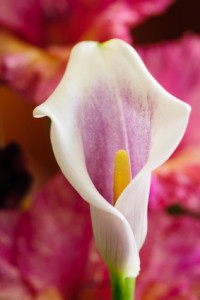Arum
The generic name of Arum, more formally known as Zantedeschia Aethiopica, is a hardy flower which is known for containing large amounts of calcium oxalate, which is extremely poisonous if ingested.
Description
The Arum have white, cone-shaped flowers with striking, glossy, arrow-shaped leaves. A strong and and solid flower, the Arum lily is also characterised by the large yellow finger-like protrusion coming from within the large white floral bract.
There are a number of cultivars, such as the more cold-tolerant, pure-white ‘Crowborough’, the ‘Green Goddess’ with its green striped spathes, the broad-spathed ‘White Sail’, the ‘Red Desire’ and its red spadix, or the ‘Pink Mist’ with pink colouring at the base of its spathe.
Habitat
Arum can be found in southern Africa, in Lesotho, South Africa, Swaziland, Mozambique, Malawi, Zambia, Tanzania and Kenya, and have also now become naturalised in Western Australia. This flower’s preferred habitat is in the margins of streams and ponds or on the banks of larger waterways.
Availability
The Arum’s large inflorescences are produced in spring, summer and autumn, evergreen where rainfall and temperatures allow, and deciduous where water is less plentiful.
Species
It is from the family Araceae and sub-family Aroideae. Araceae is a family of flowering plants in which consists of 107 genera and over 3700 species.
Care Tips
It is best to plant Arum lilies in humus-rich soil beside water, in shallow pond margins or in bog gardens, either in full or partial sun. These plants can be left outside even in frost-prone areas if they’re given deep winter mulch.
Did you know?
Arum lilies can be otherwise found under the nickname of the ‘Trumpet lily’ because it reminds us of the Archangel Gabriel’s trumpet.
Other nicknames for the Arum lily include ‘Lily of the Nile’, ‘Calla lily’ (‘Calla’ being the Greek word for ‘beautiful’) and Varkoor, an Afrikaans name meaning ‘pig’s ear’.
Arum lilies have been cultivated to be used as part of Easter celebrations for the Easter floral trade since the 20th century, hence often being commonly referred to as ‘Easter lilies’.



